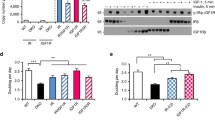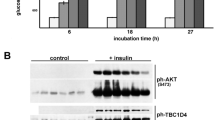Summary
It has previously been shown that insulin-induced stimulation of glucose uptake and glycogen synthesis requires activation of phosphatidylinositol-3-kinase (PI3kinase). Insulin also induces formation of RasGTP in cells and various studies have yielded inconsistent data with respect to the contribution of signalling pathways activated by RasGTP, to insulin-stimulated glucose uptake and glycogen synthesis. We have examined the requirement of RasGTP-mediated signalling for these insulin responses by expression of a dominant negative mutant of Ras (RasN17) in cells by vaccinia virus mediated gene transfer. This Ras-mutant abrogates the signalling pathways mediated by endogenous RasGTP. Subsequently, the ability of insulin to stimulate 2-deoxyglucose uptake and glycogen was examined. We observed that expression of RasN17 in 3T3L1 adipocytes did not affect the stimulation of hexose uptake by insulin. Similarly, expression of RasN17 in A14 cells, an NIH 3T3-derived cell line with high expression of insulin receptors, did not affect insulin-induced stimulation of glycogen synthesis. In both cell lines, insulin-induced phosphorylation of Mapkinase (Erk1,2) was abrogated after expression of RasN17, demonstrating the functional interference by RasN17 with signalling mediated by endogenous RasGTP. Wortmannin, an inhibitor of PBkinase, abolished dose-dependently the insulin-induced stimulation of hexose uptake and glycogen synthesis without an effect on RasGTP levels in both cell types. We conclude that stimulation of glucose transport and glycogen synthesis by insulin occurs independently of RasGTP-mediated signalling.
Similar content being viewed by others
Abbreviations
- DMEM:
-
Dulbecco's modified Eagle's medium
- ECL:
-
enhanced chemiluminescence
- MAPkinase:
-
mitogen-activated protein kinase
- PI3kinase:
-
phosphatidylinositol-3 kinase
- IRS:
-
insulin receptor substrate
- BSA:
-
bovine serum albumin
References
Pronk GJ, McGlade J, Pelicci G et al. (1993) Insulin-induced phosphorylation of the 46 and 52 kDa SHC proteins. J Biol Chem 268: 5748–5753
Sun XJ, Rothenberg P, Kahn CR et al. (1991) Structure of the insulin receptor substrate IRS1 defines a unique signal transducing protein. Nature 352: 73–77
Tobe K, Tamamoto H, Yamauchi T et al. (1995) Identification of a 190 kDa protein as novel substrate for the insulin receptor kinase functionally similar to insulin receptor substrate 1. J Biol Chem 270: 5698–5701
Burgering BMTh, Medema RH, Maassen JA et al. (1992) Insulin stimulation of gene expression mediated by p21ras activation. EMBO J 10: 1103–1109
Backer JM, Myers MG, Shoelson SE et al. (1992) Phosphatidylinositol-3-kinase is activated by association with IRS1 during insulin stimulation. EMBO J 11: 3469–3479
Cheatham B, Vlahos CJ, Cheatham L et al. (1994) Phosphatidylinositol 3-kinase is required for insulin stimulation of pp70 S6 kinase, DNA synthesis and glucose transporter translocation. Mol Cell Biol 14: 4902–4911
Ouwens DM, Van der Zon GCM, Pronk GJ et al. (1994) A mutant insulin receptor induces formation of a Shc-Grb2 complex and p21(Ras)-GTP without detectable interaction of insulin receptor substrate 1 (IRS1) with Grb2: evidence for IRS1-independent p21(Ras)GTP formation. J Biol Chem 269: 33116–33122
Sasaoka T, Draznin B, Leitner JW et al. (1994) She is the predominant signaling molecule coupling insulin receptors to activation of guanine nucleotide releasing factor and p21Ras-GTP formation. J Biol Chem 269: 10734–10738
Rodriguez-Vicania P, Warne PH, Dhand R et al. (1994) Phosphatidylinositol-3OH kinase as a direct target of Ras. Nature 370: 527–532
Sheperd PR, Nave BT, Siddle K (1995) Insulin stimulation of glycogen synthesis and glycogen synthase activity is blocked by wortmannin and rapamycin in 3T3L1 adipocytes: evidence for the involvement of phosphoinositide 3 kinase and p70 ribosomal protein S6 kinase. Biochem J 305: 25–28
Sakaue H, Hara K, Noguchi T et al. (1995) Ras-independent and wortmannin sensitive activation of glycogen synthase by insulin in Chinese hamster ovary cells. J Biol Chem 270: 11304–11309
Yamamotohonda R, Tobe K, Kaburagi Y et al. (1995) Upstream mechanisms of glycogen synthase activation by insulin and insulin-like growth factor-1. Glycogen synthase activation is antagonized by wortmannin or LY294002 but not by rapamycin or by inhibiting p21(ras). J Biol Chem 270: 2729–2734
Van den Berghe N, Ouwens DM, Maassen JA et al. (1994) Activation of the Ras/mitogen activated protein kinase signaling pathway alone is not sufficient to induce glucose uptake in 3T3L1 adipocytes. Mol Cell Biol 14: 2372–2377
Wiese RJ, Mastick CC, Lazar DF, Saltiel AR (1995) Activation of mitogen activated protein kinase and phosphatidylinositol 3′-kinase is not sufficient for the hormonal stimulation of glucose uptake, lipogenesis or glycogen synthesis in 3T3L1 adipocytes. J Biol Chem 270: 3442–3446
Manchester J, Kong XM, Lowry OH, Lawrence JC (1994) Ras signaling in the activation of glucose transport by insulin. Proc Natl Acad Sci USA 91: 4644–4648
Kozma LMK, Baltensberger JK, Klarlund A et al. (1993) The ras signaling pathway mimics insulin action on glucose transporter translocation. Proc Natl Acad Sci USA 90: 4460–4464
De Vries-Smits AMM, Burgering BMTh, Leevers SJ, Marshal CJ, Bos JL (1992) Involvement of p21ras in activation of extracellular signal regulated kinase 2. Nature 357: 602–605
Yeh JI, Gulve EA, Rameh L, Birnbaum MJ (1995) The effects of wortmannin on rat skeletal muscle: dissociation of signaling pathways for insulin- and contraction-activated hexose transport. J Biol Chem 270: 2107–2111
Lund S, Holman GD, Schmitz O, Pedersen O (1995) Contraction stimulates translocation of glucose transporter Glut4 in skeletal muscle through a mechanism distinct from that of insulin. Proc Natl Acad Sci USA 92: 5817–5821
Yon M, Dai T, Deak JC et al. (1994) Activation of stress-activated protein kinase by Mekk1 phosphorylation of its activator SEK1. Nature 372: 798–800
Koong AC, Chen EY, Mivechi NF et al. (1994) Hypoxia activation of nuclear factor kappa B is mediated by a ras and raf signaling pathway and does not involve MAP kinaseinase (Erk1 or Erk2). Cancer Res 54: 5273–5279
Hausdorff SF, Frangioni JV, Birnbaum MJ (1994) Role of p21ras in insulin-stimulated glucose transport in 3T3L1 adipocytes. J Biol Chem 269: 21391–21394
Galante P, Mosthaf L, Kellerer M et al. (1995) Acute hyperglycemia provides an insulin independent inducer for Glut 4 translocation in C2C12 myotubes and rat skeletal muscle. Diabetes 44: 646–651
Author information
Authors and Affiliations
Rights and permissions
About this article
Cite this article
Dorrestijn, J., Ouwens, D.M., Van den Berghe, N. et al. Expression of a dominant-negative Ras mutant does not affect stimulation of glucose uptake and glycogen synthesis by insulin. Diabetologia 39, 558–563 (1996). https://doi.org/10.1007/BF00403302
Received:
Revised:
Issue Date:
DOI: https://doi.org/10.1007/BF00403302




